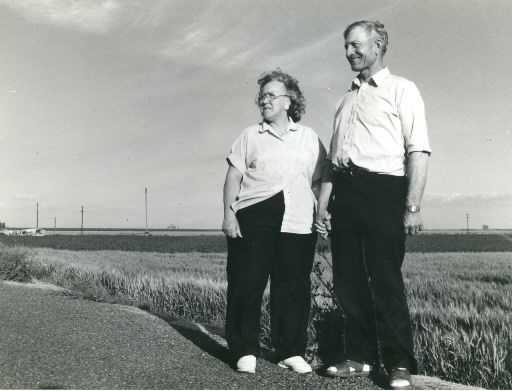5. The ‘Mile of Death’
Jan. 5, 2013
Chapter 1: The United States
Part 1: Hanford's Hidden Past
Part 1: Hanford's Hidden Past
Northeast of the Tri-city, beyond Hanford's cluster of reactors, lies the vast agricultural belt of the Columbia Basin. The town of Mesa is the center of the region; a typical small town consisting of a couple of diners and three general stores, home to three thousand people. It was in Mesa that we were able to gauge for the first time the true feelings of those living near the plant. There we spoke to Robert and Betty Perkes, who own a farm in the region. After the conspiracy of silence in the Tri-city towns we were amazed at their frankness: "Go ahead and tell the world. America has created nuclear weapons. At the same time it's also created thousands of victims." The couple, both born in Idaho, married and came to Mesa in 1953. Robert was an ex-serviceman; the area had been recommended by the army. The Perkes worked hard to build a new life for themselves. They got rid of the weeds, bulldozed the rocks away, and planted wheat, potatoes, and beets. Betty gave birth to six children on the farm.
Their second son died two days after he was born; his lungs had not developed properly. The Perkes's three daughters all suffer from thyroid conditions, and Betty has had a tumor removed from her breast. Robert himself is also on medication for a thyroid problem. It was 1986 when they first made the connection with Hanford, thanks to Karen Steele's article. As Betty Perkes told us, the article "solved the mystery of all those strange incidents over the years."
Deformed cows and goats had been born on neighboring farms. ADC-3 had flown over every two or three days with a large bag hanging from it. Someone from the military came round to survey the family's health, giving no name or rank.
"He must have been checking whether the radiation had had any effect," Betty said with a shiver. "At the time Robert and I were busy with work and bringing up the kids—we didn't have a moment to think about it. We didn't even know they were making atomic bombs there, and naturally it had never occurred to us that land recommended by the army would be contaminated by radiation." When Robert Perkes found out about the contamination, he teamed up with Tom Bailie, a fellow farmer who had at one time run for a seat in the state legislature. The two men conducted a survey of their own, visiting the twenty-eight homes in the square mile around the Perkes's farm. Most were owned by ex-servicemen. They were profoundly shocked by what they discovered. One woman had had seven miscarriages, another had lost her daughter to bone cancer. There was a mother who had killed her deformed baby and then herself; a home deserted when the father had died of cancer...the list went on. Of the twenty-eight families surveyed, only one had no health problems. The area became known as the "mile of death."
The Mesa region, stretching from the east to the northeast of the Hanford nuclear complex, lies directly in the path of a westerly wind that often blows through the Columbia Basin. "There's no doubt we were on the receiving end of a lot of fallout," Perkes said. "We had no idea that our milk, meat, and vegetables were riddled with radiation. If only we'd known, we'd never have let them get away with this careless disregard for our lives for so long." The relaxed expression left Robert Perkes's face as he spoke these bitter words.
According to investigations carried out by a number of groups, radioactive material was not only discharged from the plant into the atmosphere, but was also found to have leaked out of underground tanks, threatening contamination of the water table. "The nuclear contamination is not something that happened in the past. It's happening now, with the groundwater, the river, the soil--if we were to look into other areas around here, I know we would find a host of other places that deserve the name 'mile of death'…the tragedy is just beginning to unfold."








